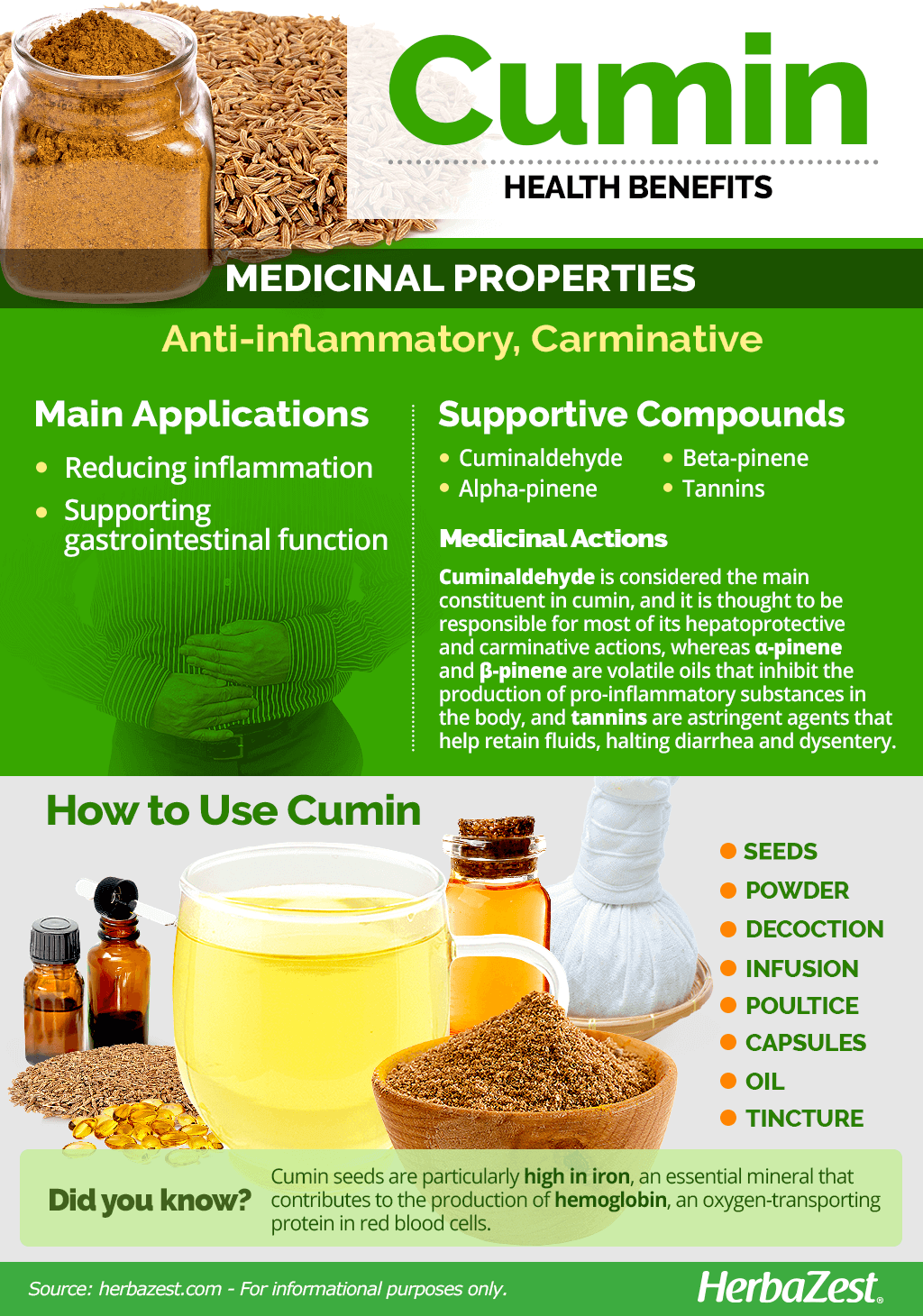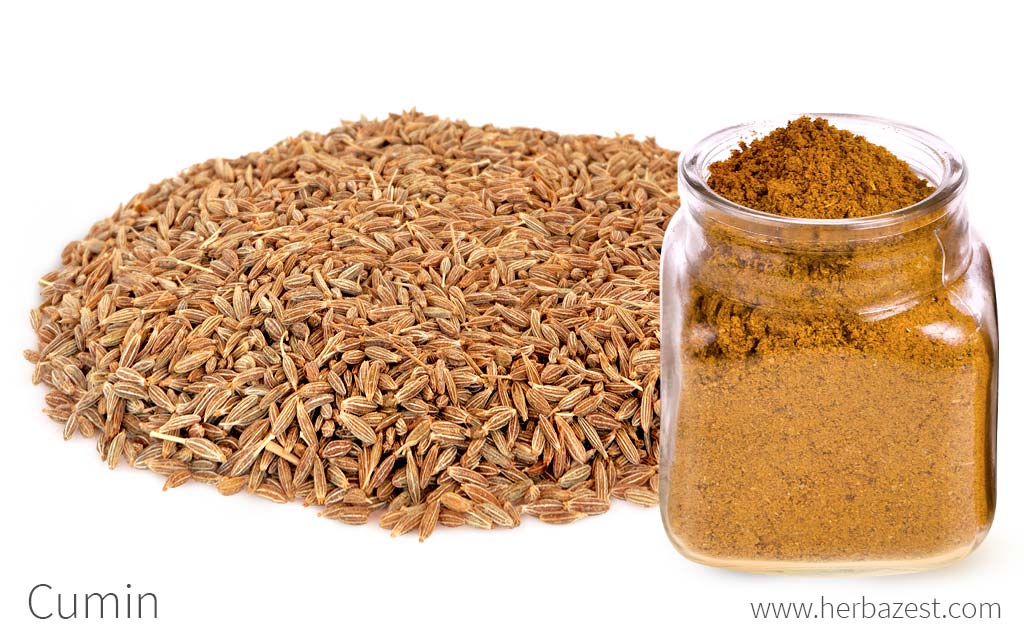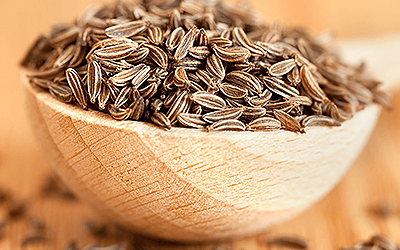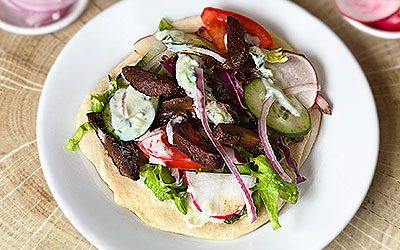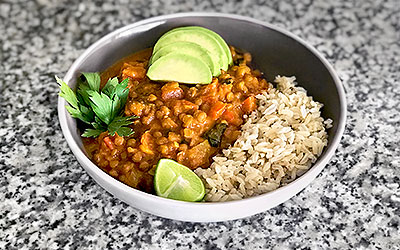Cumin has been cultivated in Europe and Egypt since antiquity. It is a popular addition to South Asian, North African, and Latin American cuisines, and it's even found in some cheeses. As a medicinal plant, cumin has traditionally been utilized as an antispasmodic, carminative, sedative, and stimulant, with reported antibacterial activity.
Cumin Medicinal Properties
Health Benefits of Cumin
Since ancient times, cumin has been traditionally used for treating a variety of conditions. The most notable cumin's health benefits include:
Reducing inflammation. Cumin has anti-inflammatory and antioxidant effects, which help improve rheumatoid arthritis, atherosclerosis, periodontitis, ulcers, and other inflammatory diseases.
Supporting gastrointestinal function. The carminative properties of cumin can help alleviate flatulence, indigestion, bloating, and diarrhea.
On the other hand, modern scientific research suggests that cumin's properties can also be helpful for:
Healing wounds. Cumin has been shown to encourage tissue regeneration, protect wounds from infections, and reduce bleeding from abrasions.
Promoting healthy liver function. Cumin helps regulate the activity of the liver, which makes it useful for treating diseases such as chronic hepatitis.
Additionally, cumin has shown antihyperlipidemic properties in preliminary studies, which may be beneficial for treating diabetes risk factors, such as obesity, high cholesterol, and high triglycerides.
How It Works
Cuminaldehyde is considered the main constituent of Cuminum cyminum, and it is thought to be responsible for most of its medicinal benefits. Other phytochemicals in cumin are γ-terpinene, o-cymene, limonene, α-pinene, and β-pinene.
The anti-inflammatory activities of cumin have been attributed to its volatile oils, mainly α-pinene and β-pinene. It is thought that these compounds inhibit the production of pro-inflammatory substances in the body, mainly cytokines and prostaglandins, thus suppressing the inflammatory response in arthritis, rheumatism, and other diseases.1
Cumin has long been considered a hepatoprotective and carminative agent. This is because its seeds have the ability to increase stomach acids and bile secretion, which not only aids the digestive processes, but also improves liver function.2
All main compounds of cumin's essential oil have shown strong antimicrobial activity against mold, such as Aspergillus niger; bacteria, such as Bacillus subtilis and Staphylococcus epidermidis; and yeast, such as Saccharomyces cerevisiae and Candida albicans.3 The phytoconstituents in cumin assist in decreasing the period of epithelialization and inhibiting microbial growth to promote wound healing.
The tannins in cumin are astringent agents that tighten and contract human tissue to retain fluid, halting diarrhea and dysentery.
Cuminaldehyde has been associated with reduced body weight, cholesterol, phospholipids, free fatty acids, triglycerides, and blood sugar.
Other herbs with both anti-inflammatory and carminative properties are allspice, oregano, cardamom, and chamomile.
Cumin Side Effects
While cumin is generally recognized safe when used as a condiment and essential oil, excessive amounts of the spice could lead to heartburn, excessive belching, and nausea, as well as skin rashes when applied topically.
Cumin Cautions
Since the herb may slow down blood clotting and lower blood sugar levels, people taking anticoagulant drugs (blood thinners) and diabetics under medical treatment should consult to a doctor before taking cumin in medicinal doses. Likewise, people due to undergo surgery should avoid cumin use at least two weeks before their scheduled procedure.
There is not enough reliable information regarding the safety of cumin for women who are pregnant or nursing, but the spice is traditionally believed to be an emmenagogue, potentially leading to bleeding and premature labor. It is best to stay on the safe side and avoid use in medicinal doses.
- Medicinal action Anti-inflammatory, Carminative
- Key constituents Cuminaldehyde, alpha-pinene, beta-pinene, tannins
- Ways to use Capsules, Decoctions, Hot infusions/tisanes, Tincture, Poultice, Powder, Essential oil, Dried
- Medicinal rating (3) Reasonably useful plant
- Safety ranking Use with caution
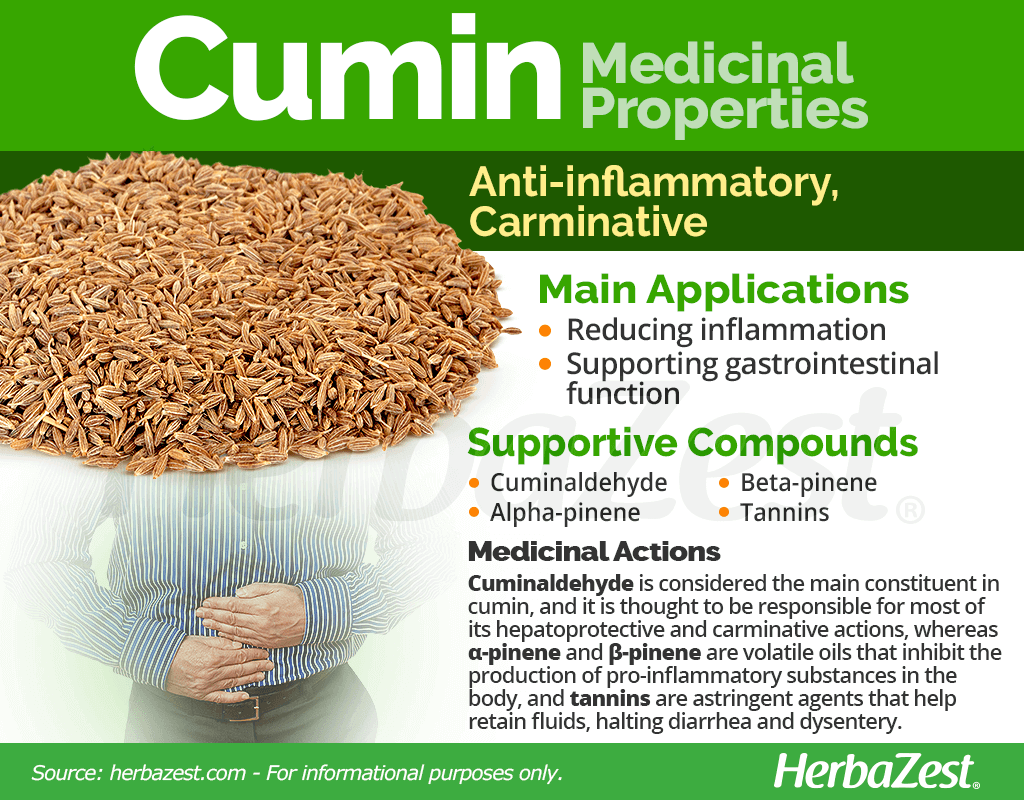
Cumin Nutrition
Cumin's benefits go beyond its medicinal and flavoring uses. In fact, cumin spice offers an array of vitamins and minerals which, due to the primary use of this herb as a spice, are provided mostly in trace amounts. Nonetheless, they help increase the nutritional content of many dishes.
Cumin seeds are particularly high in iron, an essential mineral that contributes to the production of hemoglobin, an oxygen-transporting protein in red blood cells. Appropriate levels of iron in the body optimize blood circulation, increase cognitive function, and decrease the likelihood of developing cognitive disorders, such as dementia, as well as anemia related to iron deficiency.
Additionally, cumin provides small amounts of manganese, copper, magnesium, and calcium, along negligible concentrations of many other minerals and vitamins.
A teaspoon of cumin seeds (2.1 g) provides 8 calories, as well as 1% of the daily value for protein and dietary fiber.
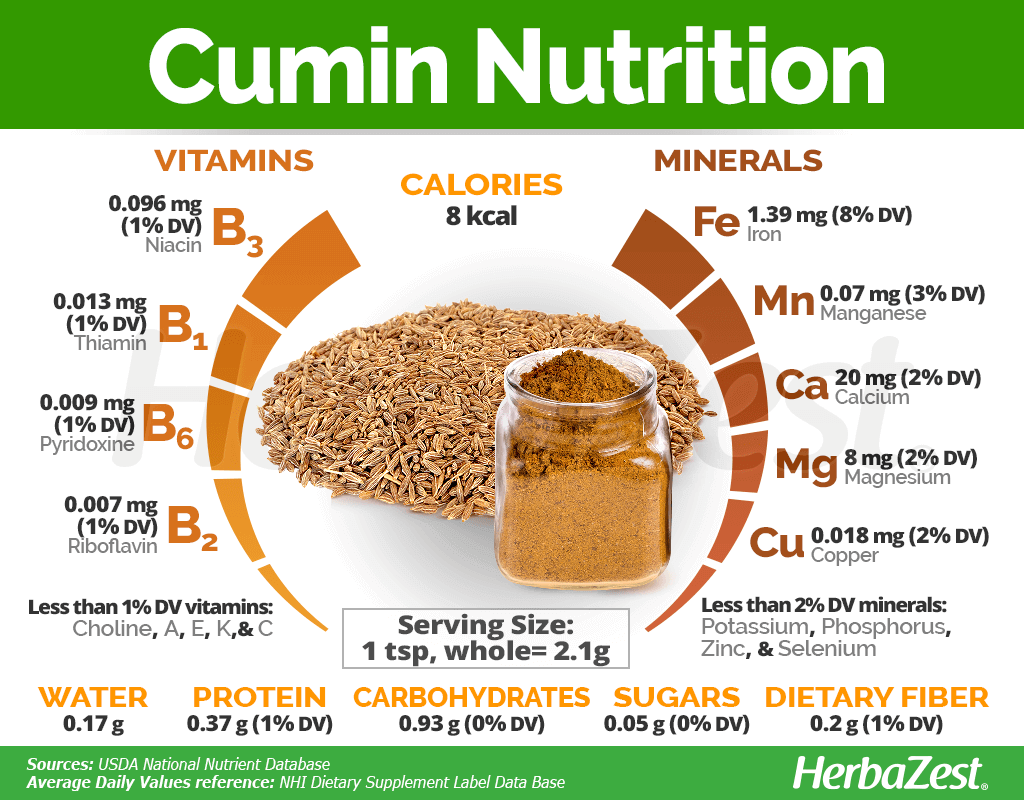
How to Consume Cumin
The cumin spice is consumed whole, powdered, or as an essential oil in culinary applications and recipes. The characteristic aroma of cumin is caused by cuminaldehydes within the oil, which have a warm, earthy fragrance with a lingering pungency. The flavor is primarily bitter but with a sweet aftertaste.
Cumin is used whole, powdered, or as an essential oil as a condiment in cheeses, pickles, sausages, soups, stews, stuffings, rice, and bean dishes. It is also a flavoring ingredient for liqueurs.
The cumin spice is the key ingredient in various types of curries and chili powders as well as in Cajun spice mixes.
Cumin's benefits and traditional applications have lead to the existence of many herbal remedies, which can help alleviate a variety of health conditions.
Natural Forms
Seeds. Whole, dried cumin seeds are consumed to support digestion and lactation as well as improve immunity. Cumin seeds also have antimicrobial and antifungal properties to fight against colds, bronchitis, asthma, and skin disorder infections.
Powder. Consuming powdered cumin is believed to help jump-start weight loss.
Decoction. Traditionally, Arabs consumed a decoction made from ground cumin seed and lime for colic.
Infusion. A cumin infusion made from cumin leaves steeped in vinegar can be consumed for diarrhea.
Poultice. In North Africa, a poultice of cumin leaves was placed on the nape of the neck for lumps. It was also used by Ethiopians for skin disorders.
Herbal Remedies & Supplements
Capsules. Cumin seed oil supplements are believed to promote digestive and colon wellness.
Oil. Cumin seed oil is often blended with other oils, such as buckthorn and pumpkin, to support a healthy immune system. Lebanese have traditionally used cumin seed oil for cramps, syncope, and tachycardia.
Tincture. Cumin tincture is used to enhance immunity.
- Edible parts Seed, Oil
- Edible uses Condiment
- Taste Aromatic, Earthy, Pungent
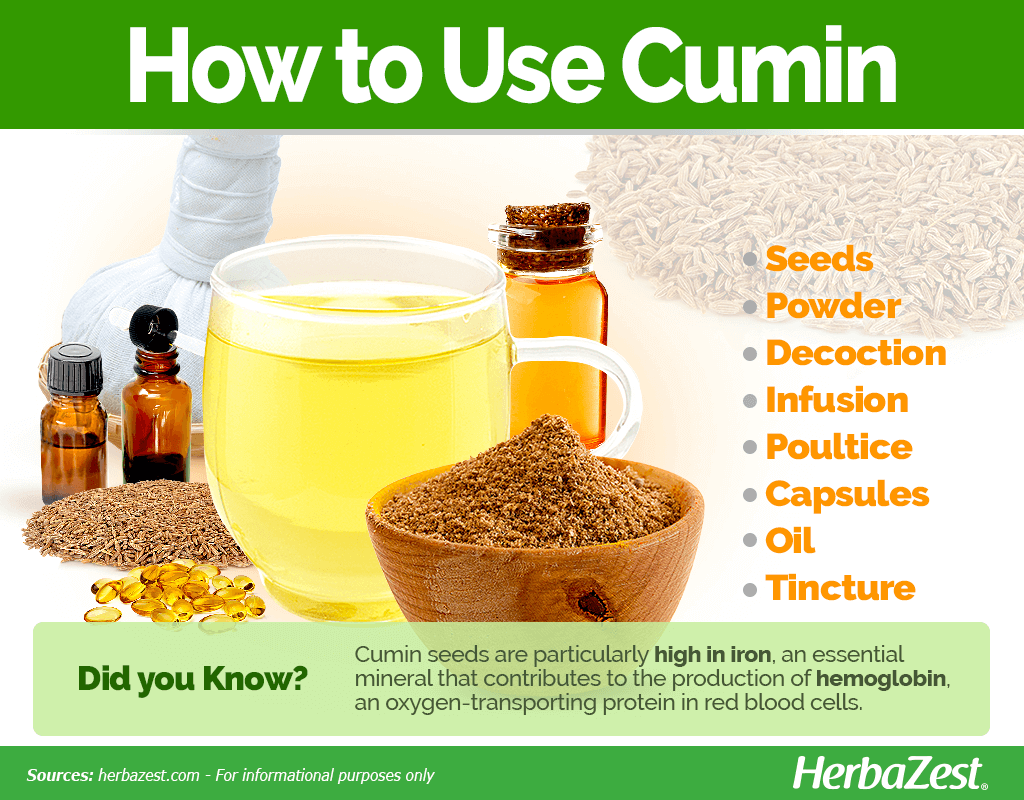
Growing
Cumin is a small annual herb possibly native to the Mediterranean region. It is easy to grow under the right conditions; however, cumin will not tolerate long periods of dry heat and needs mild temperatures, especially during its first three to four months of growing.
The cumin plant tolerates different types of soils, from light sandy to heavy clay loam as long as they are well-drained. A neutral to alkaline pH of 6.8 - 8.3 is ideal for this herb.
It grows best when planted in a sheltered, sunny position, with an optimum temperature range of 63 - 79°F (17 - 26°C).
- The cumin plant is typically propagated by seeds, which should be sown directly on previously plowed soil, immediately after the last frost.
- Since cumin is commonly cultivated in arid and semiarid regions, its water needs are moderate, but care should be taken to keep the soil moist without overwatering it.
- Cumin is ready to harvest when its fruits become yellow-brown, which usually happens four to five weeks after flowering.
Some pests can attack the cumin plant, like aphids, caterpillars, mites, and larvae.
Cumin is also susceptible to a range of diseases, mostly blight, wilt, and powdery mildew.
More detailed information about growing cumin can be found in the herb garden section.
- Life cycle Annual
- Harvested parts Seeds
- Light requirements Full sun, Partial shade
- Soil Light (sandy), Medium (loam), Clay loam, Well-drained
- Soil pH 6.6 – 7.3 (Neutral), 7.4 – 7.8 (Slightly alkaline), 7.9 – 8.4 (Moderately alkaline)
- Growing habitat Mediterranean regions
- Planting time Right after last frost
- Plant spacing average 0.1 m (0.30 ft)
- Growing time 3 - 4 months after sowing
- Potential insect pests Aphids, Mites, Caterpillars
- Potential diseases Bacterial blight, Fusarium wilt, Powdery mildew
Additional Information
Plant Biology
Cumin is a small annual herb that grows 6 - 20 inches (15-50 cm) high and has a thin taproot as well as finely grooved and branched stems that tend to droop. Its leaves are bluish-green, alternated and divided in thread-like segments. The plant is hairless and has a glossy appearance. Inconspicuous white or pink flowers are borne from umbels that are about 1.5 inches (4 cm) in diameter. The fruit is rounded, one to two inches (3-6 cm) in length, and contains two carpels. The seeds inside are yellow-brown and hairy.
Classification
Cumin is a member of the Apiaceae (Umbelliferae) family, which is comprised of about 300 genera and 3,000 species that are commonly distinguished by their umbellate inflorescence and hollow stems. Notable members of this family are anise (Pimpinella anisum), carrot (Daucus carota), celery (Apium graveolens), dill (Anethum graveolens), fennel (Foeniculum vulgare), and parsley (Petroselinum crispum).
Related Species
Cuminum cyminum, also known as "green cumin," is the only species in the genus Cuminum. However, it is closely related to other seed spices that also belong to the Apiaceae family.
It is important to note that Nigella sativa and Bunium persicum, although both known as 'black cumin,' are not related in any way to C. cyminum.
Historical Information
Cumin is though to have originated in the eastern Mediterranean region and southwest Asia. The earliest records of cumin cultivation are from the Mesopotamian civilizations, where the fruit of cumin was highly prized as flavoring agent. Its medicinal properties were also valued by the Egyptians and are mentioned in the Eber Papyrus, dating back to 1550 BCE. The spice was also well-known by the Romans, who used cumin seeds as an alternative to pepper.
Cumin is mentioned in the Christian Bible and the Jewish Torah and remains an essential ingredient of many traditional Mediterranean dishes, particularly in Egypt, Turkey, Israel, Jordan, Lebanon, Palestine, and Syria.
It is thought that cumin was introduced to North America by Spanish or Portuguese traders.
Popular Beliefs
In Ancient Greece, cumin was associated with cupidity and, by the first century, Roman emperor Marcus Aurelius was nicknamed 'Cumin' because of his extreme greediness.
Economic Data
The global production of cumin amounts to around 200,000 tonnes. While India, Syria, Turkey, and Iran are major producers of the spice, India is the largest exporter, with around 50,000 tonnes annually (75% of the total production). The U.S., U.K., and Brazil are the leading importers of Indian cumin seeds.
Other Uses
Cosmetics. Due to its strongly aromatic properties, cumin's essential oil is used in the cosmetic industry, particularly in perfumery.
Veterinary medicine. The healing properties of cumin seeds are also used to treat indigestion, flatulence, and diarrhea in animals.
Additionally, cumin's antibacterial action has also been useful against a wide range of bacteria responsible for many cultivated mushroom diseases around the world.
- Other uses Perfume
Sources
- ATTRA - Sustainable Agriculture Program, Seed Spices: Cumin, Dill, Anise, Fennel, Caraway, Ajwain
- Chartered Institute of Procurement & Supply, Cumin:commodity factsheet
- Duke's Handbook of Medicinal Plants of the Bible, p. 159
- Edible Medicinal And Non-Medicinal Plants, Volume 5, Fruits, p. 32
- Guide to Cultivated Plants, p. 312
- IOSR Journal of Pharmacy and Biological Sciences, The pharmacological activities of Cuminum cyminum - A review, 2016
- Neuropsychiatric Disease and Treatment, Iron deficiency and cognitive functions, 2014
- Pharmacognosy Review, Cuminum cyminum and Carum carvi: An update, 2011
- Purdue University, Cumin
- Spice Crops, pp. 261-268
- University of Iowa, Cumin
- Evidence-based Complementary and Alternative Medicine, Practices in Wound Healing Studies of Plants, 2011
- Advances in Food and Nutrition Research, Volume 67, pp. 99-100
Footnotes:
- Der Pharma Chemica. (2010). Antiinflammatory activity of fruits of Cuminum cyminum Linn. Retrieved June 16, from https://www.researchgate.net/publication/267227632_Antiinflammatory_activity_of_fruits_of_Cuminum_cyminum_Linn
- International Journal of Pharmaceutical & Biological Archives. (2011). Protective Effect of Cuminum cyminum and Coriandrum sativum on Profenofos Induced Liver Toxicity. Retrieved June 16, from https://www.semanticscholar.org/paper/Protective-Effect-of-Cuminum-cyminum-and-Coriandrum-Kumar/65304b2a312d5d8a26e723576ae922684f157209
- Journal of Food Science. (2010). Antimicrobial property, antioxidant capacity, and cytotoxicity of essential oil from cumin produced in Iran. Retrieved June 16, from https://pubmed.ncbi.nlm.nih.gov/20492235/
